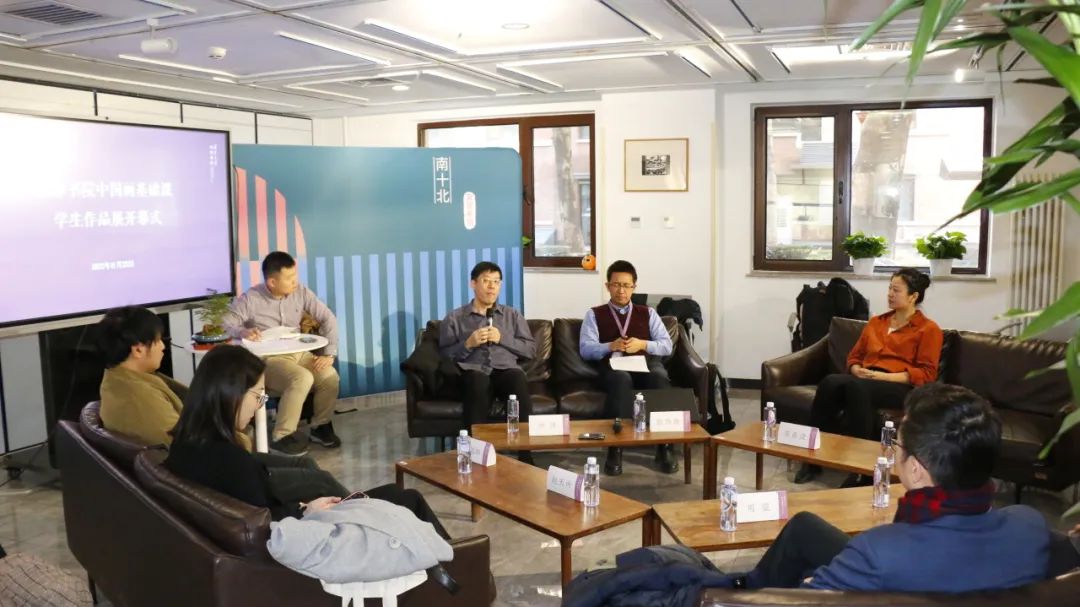On November 23, in sunny weather, an abundant and enchanting display of natural landscapes, flowers and birds could be seen in the first floor hall at Xinya College. The opening ceremony for the third phase of the Xinya painting workshops, the 2023 Xinya College exhibition of students' works from the course “Basic Chinese Painting” opened that morning. This exhibition presented a collection of 21 works by 10 students from Xinya College and Rixin College. Each piece revealed a student’s unique perception of, and pursuit of, beauty, expressing their emotions and philosophy. Guests in the opening ceremony included Ms. Zhao Tianye, a residential scholar from Hangzhou Traditional Chinese Painting Art Gallery, who was in charge of the “Basic Chinese Painting” course; Mr. Zhou Wang, from Prince Gong's Mansion Museum, teacher of the autumn semester 2022 “Basic Chinese Bird-and-Flower Painting” course; Mr. Chen Sanyin from China National Academy of Painting, teacher of the spring semester 2023 “Basic Chinese Landscape Painting Copying” course; Ms. Li Yanwen, from Xinghai Conservatory of Music, teacher of Xinya's “Composition and Painting” course ; Mr. Gu Tao, deputy dean of Rixin College and associate professor in the Department of History, Tsinghua University; and Mr. Zhang Weite, deputy dean of Xinya College, along with teachers and students from both Xinya College and Rixin College. The opening ceremony was presided over by Mr. Zhang Yuanzhe, head of the student working group at Xinya College.

Ms. Zhao Tianye commended the Xinya painting workshops’ successful execution, praising Xinya College for its innovative explorations in aesthetic education. In particular, Ms. Zhao emphasized that the core objective of the “Basic Chinese Painting” course lay in respecting one's inner passions and venerating Chinese traditional culture. She emphasized that Chinese painting is a paramount component of Chinese civilization, that plays a pivotal role in both the perpetuation of tradition, and innovation, in modern university education.
Mr. Zhou Wang reflected upon his teaching work, utilizing a Song Dynasty sketch of daffodils as his fundamental teaching content. His aspiration was for students to transition from being "friends of painting" to becoming "friends of flowers". Last winter, Mr. Zhou had encouraged everyone in his class to grow a pot of daffodils in order to witness their growth and blossoming. He believed that in bird-and-flower painting, technique should not be the primary focus; instead, its true essence lay in bringing comfort to people's lives and nurturing their inner spirituality. Being able to focus upon capturing the posture of a daffodil, or patiently awaiting the sprouting of a bulb, essentially represented an attempt to integrate the relationship between humanity and nature into an appreciation of daily life.
Mr. Chen Sanyin reminisced concerning his teaching process, which involved the use of Southern Song Dynasty landscape paintings as materials for copying, in order to impart technique. Lavishing praise upon the students' creativity and aptitude for learning, he encouraged them not to abandon their paintbrushes outside the classroom, but rather to continue to expand their exploration from the depiction of landscapes on paper to delving into the meanings of their own lives.
Ms. Li Yanwen lauded the students' artistic expression from the perspective of composition and painting. In their exercises, she sensed melodies and discerned characters. Ms. Li emphasized that the teaching of techniques provides the essential entry point into the realm of art, identifying the teaching and guidance of students in the mastery of techniques as an efficient way to help them delve into art appreciation and immerse themselves in art history‘s rich tapestry.
Mr. Gu Tao analyzed the significance of the “Basic Chinese Painting” course from the dialectical standpoint of the Chinese philosophical concepts of Qi and Dao. He emphasized that discussion of Dao without considering Qi could only result in empty rhetoric. Learning practices at the level of Qi — how to hold and wield a pen, and drawing and wash painting techniques, for instance — could compensate for current shortcomings in specialist education. Mr. Gu also considered experiential teaching an integral part of general education.
Mr. Zhang Weite expressed his gratitude on behalf of the college to the three teachers for leading painting workshops at Xinya. He believed that these workshops had instilled courage in students with no prior painting experience, stimulating their internal drive and enriching their physical and mental well-being through experiential creation. Not only had they enriched the culture of Xinya College, but they had also yielded remarkable results. The not-for-credit Chinese painting course including these workshops was aligned with the themes of the two major domains contained within the Xinya College general knowledge system, "Literature, Art, and Aesthetics" and "Chinese Civilization". Furthermore, through its small-class "master-apprentice" teaching approach, the course had upheld the educational tradition of ancient academies.
Creation necessitated close observation rather than a detached perspective; art and culture were the fundamental principles of Chinese paintings. In pursuing aesthetic education goals, the value of practical experiences — the tactile impression of Xuan paper, the texture of wash painting, the three-knuckle grip in which the brush is held — was worthy of emphasis.